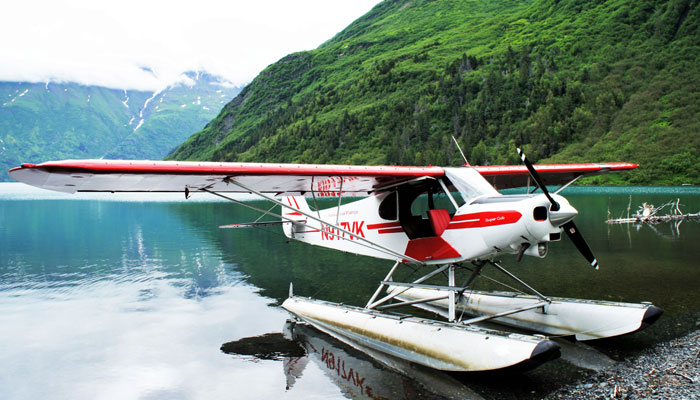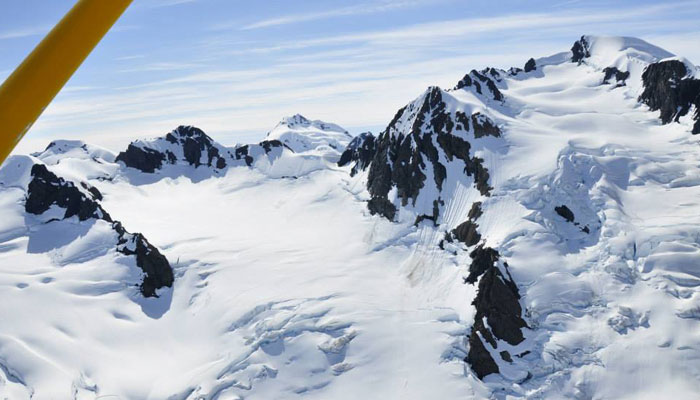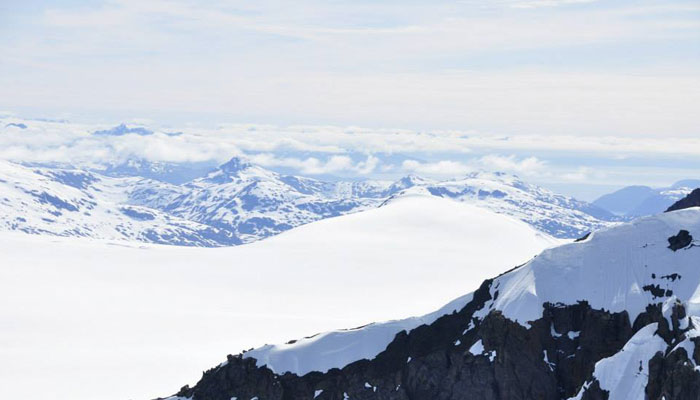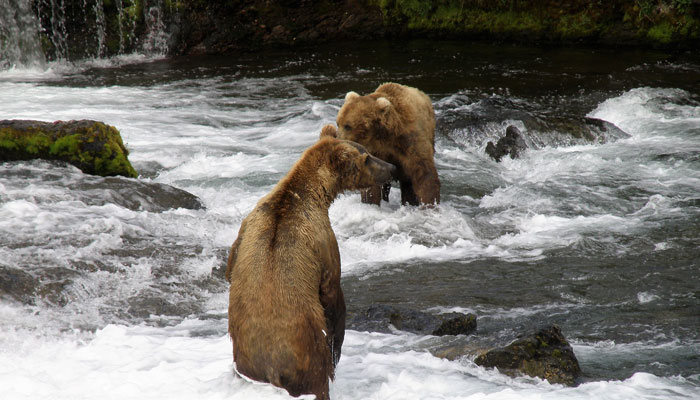Alaska on Floats
By Derek and Morag Jones
Flyer, March 2009, www.flyer.co.uk
(Printed with permission)
This year it was Mo’s turn to choose the holiday. Perhaps we might go flying, sailing, ride motorbikes or drive classic cars? Nope. “The International Wild Waterfowl Association is meeting for their 50th anniversary in Anchorage, and we’re going to visit wildlife places then get on a cruise ship down to Vancouver.”
“Er…right.”
A bit of Googling revealed the following: Alaska has six times the number of licensed pilots per head of population than anywhere else in the USA. Lake Hood at Anchorage has a higher number of floatplanes in one place than anywhere else in the world. Lake Hood airstrip, one of the two GA fields-Merrill Field is the other-has over 450 based light aircraft. Why so many? Well, apart from the road and rail links north to Fairbanks (about 300 miles) and south down the Kenai Peninsula to Whittier (the deepwater port) and to Seward and Homer, there are very few decent roads in this vast and wild territory, and certainly not in the winter. Amazingly, the state’s capital, Juneau, can only be reached by air or sea.
Following our last floatplane flying adventure around Vancouver (FLYER March 2007), we were keen to continue and possibly add some taildragger time. However, trying to organize dual flying in floatplanes and taildraggers well ahead of our visit proved to be frustrating-with emails unanswered, call-backs that didn’t happen, or suggestions to call with a few days to go. Part of the problem seemed to e the short summer season: June to mid-September is crammed with a vast amount of tourist flightseeing, whale watching, glacier experiences etc. Two itinerant Brits seemed to come a bit low on the totem pole. (Actually, this saying, we later found out from a carver of totem poles, is based on a misunderstanding-the lowest effigy on the pole is the senior!)
Eventually we managed to make contact with a relatively new outfit, Land and Sea Aviation at Merrill Field who had a Champion 7ECCA taildragger and a Champion 7GCBC on floats.
As we let down into Anchorage in an Alaska Airlines 737, it was a completely blue day with visibility for ever and the vistas of snow-capped mountains stretched away on either side as far as the eye could see. Next morning the weather reverted to what apparently more the norm for this time of year: grey misty skies and intermittent rain.

At Land and Sea we were greeted by Mike Field with bad news. “The floatplane is u/s” Aargh! So it was down to flying the 7ECA. This one had the 118 hp Lycoming and the original wooden-sparred wings, although a set of metal-sparred wings were being built in the workshop.
Mo chose to use the time to polish her taildragger handling, and this demonstrated why Anchorage may not be the ideal area for training-aside from considerable local traffic, Merrill Field and Lake Hood are sandwiched between the International Airport to the south and Elmendorf USAF Base to the north. To practice involved wasting time going to a quieter area.
I elected to visit the Knik Glacier first (when in Rome). One thing Alaska has, as well as oil and minerals, is a lot of glaciers the larger ones are truly spectacular. The material they pick up colours some of them-others are truly white with blue tinges when the sun is on them. So a right turn after take-off and we followed the east bank of the Knik Arm of the Cook Inlet with the Chugach Mountains to our starboard side, climbing laboriously to 1,500ft and then cruising at 75-80kt Mike confirmed that the engine was “a bit tired and due for replacement”.
Glaciers Galore
As we progressed up the valley, one feature of Alaskan aviation became apparent: the big differences in wind and weather experienced over relatively short distances. On take-off the wind had been negligible. Now the katabolic flow off the glacier progressively in increased until we were going nowhere fast and the turbulence was uncomfortable. We turned back and the wind spat us out of the valley. We crossed the Knik Arm to Goose Bay strip, with its gravel surface in a space carved among the trees.
Here I ran through the gamut of tailwheel techniques including wheelers and three-pointers from normal and glide approaches. The 7ECA has no flaps and the directional stability felt a bit loose, with a noticeable adverse yaw to keep the feet busy. The rudder was sufficiently powerful to make steep sideslips available if required to adjust the touchdown point. The elevators had plenty of power for the roundout and, annoyingly, I kept touching down slightly tailwheel first. This is in contrast to the parachute Cessna 185 that I sometimes fly, which is difficult to get tail-down when empty.
While in this area, we took the once-a-day northbound Alaska Railroad train to Denali-complete with the traditional cry of “Boooard” from the conductor. The train is of improbable length, making it a fair hike to the restaurant car. It also has double-deck observation cars, useful to see over the trees that border much of the line.
The Denali National Park and Preserve is just one of many in Alaska and not the biggest-though I count six-million acres as vast. It includes part of the Alaska Range and Mount McKinley. At 20,320ft that’s the tallest mountain in America, notorious for its extreme weather-I recommend Wager with the Wind by James Greiner, chronicling the life and hair-raising flying experiences of Don Sheldon on his rescue and other missions in this area.


Wildlife watching
In the park, we watched grizzly bears, moose, caribou, Dall sheep and wolves-mainly at long range, requiring good binoculars and long lenses. The exception was a rather grumpy looking moose and a wolf loping unconcernedly along the road. Truthfully you should go to the park just to experience the sheer grandeur and, if you are lucky, glimpses of Mount McKinley through the ever-present cloud.
For some floatplane time, Mike had recommended contacting Alaska Float Ratings at Moose Pass, down the Kenai Peninsula. I had not considered them as I thought Anchorage would have everything, and Moose Pass is two hour’s drive south, and required us to hire a car. However, not only is the operation a gem, and the local terrain with its surrounding mountains and wide variety of lakes and water conditions ideal for float training and refreshers, but within range there are ice fields, glaciers and the mountains of the Kenai Fjords National Park. And the scenery on the journey down was a real bonus.
The road followed the north bank of the Cook Inlet and the Turn again Arm before turning south to Moose Pass. The towering mountains on each side of the arm funneled the wind and lowering clouds down over the water , creating a wild and rather forbidding grandeur. We saw beluga whales coming up the arm on the flood tide that is sometimes strong enough to create a six-foot bore of water. Between the road and the water all the spruce trees stand leafless and dead adding to the stark landscape.

Dump full-flap
Alaska Float Ratings is located at Upper Trail Lake, just off the highway at Moose Pass. The original Iditarod Trail was blazed through this valley in 1910-11 to take supplies to the goldfields and bring back the gold.
Vern and Laura Kingsford run Alaska Float Ratings and Scenic Mountain Air. They have three 150hp Piper Super Cub floatplanes, one with 2,100lb mauw and belly-pannier. The one I flew had leading-edge vortex generators, presumably to improve the already good Cub handling at the stall. There is also a 180hp Cessna 172 and a Cessna 206 available.
Accommodation is available on site.


Vern, like me, is approaching the Big 7-0. He has 18,000 hours with 7,500 of those on floats. And we share a love of flying and a wish to pass on our experience to others-when you ask Vern for a float refresher, he doesn’t mess about. I had one of the most concentrated periods of practice in the air and on the water that I have ever had.
No time is wasted as the area has everything you need for float-flying, either on the spot or cose to. Six local lakes range from big to small, with all the varieties of wind (or lack of it) and turbulence that you could possibly wish for. All this is with the experience of dealing with the mountain flying problems thrown in for free, plus stunning scenery.
Mo went off to play, coached by Darlene Kellog, who has more than 15,000 hours, while Vern and I got stuck into it. In quick succession we covered the lot, from normal take-offs and landings, glassy water techniques, rough water operations, glide approaches, lifting a float to get a heavily-loaded aircraft off glassy water and finally how to take off from a small lake: full power, up on the step, then at the critical moment, dump full-flap, pop off the water then gently bleed off the flap as you accelerate to climb speed.
Then we went back to the water for another of Vern’s challenging exercises in the misty conditions with rain on the windscreen. Take-off, then throttle back and, maintaining the step attitude, hold the height at two inches above the water by varying the power. I didn’t satisfy his exacting standards!
I got another verbal smack on the wrist for trying to control a nose-high attitude in the step taxi with stick rather than power. After step turns it was time to return from this trip. On the way back at low level, Vern suddenly took control, dipped the wing and there was a black bear ambling happily along the railroad track.
An approach over the trestle bridge and a bigger thump onto the water than I would have liked and that was the refresher. The Kenai Fjords National Park really does have it all from the flying point of view. Mountains, glaciers, ice fields, coastlines, lakes aplenty, and it’s all in Class G airspace. It would have been nice to take advantage of the flying safaris, which can be anything up to three weeks if you wish. But it was back to the tourist bit on the cruise ship, and a bit more flying…
We saw whales on an excursion from Juneau. During a jet boat trip from Skagway we watches bald eagles perched in the trees-I never actually saw them move, perhaps it is part of their job description to keep still for tourists’ cameras. And at Ketchikan we hit the road on Harley-Davidson motorbikes-and enjoyed a flight with Dave Rocke of Family Air in a Cessna 185 floatplane.
The less than ideal weather added to the interest as this was one of the 400-odd aircraft in Alaska fitted, at the FAA’s expense, with Automatic Dependent Surveillance-Broadcast (ADS-B) equipment, in order to make for a realistic trial. This is an alternative to Mode S.
Briefly, ADS-B is a GPS-based system where the aircraft equipment establishes its position, track and altitude and transmits this to a remote ground station and thereafter by landline or satellite link to the ATC. Crucially this information is also received and displayed in the cockpit of other ADS-B equipped aircraft in the area. The result is that everybody participating knows where everybody else is in relation to them, without ATC chatter.
This was particularly well shown on our trip where there was low cloud and poor vis, but still plenty of conflicting traffic. Y contrast, it was much more difficult to sight a non ADS-B aircraft of which we were warned by traditional radar-bases air traffic information, with the inevitable built-in delay.
The cockpit display chosen by Dave was basic terrain information overlaid with a pseudo HIS and graphical presentation of our and other aircrafts’ position and track. It must be said that this system is particularly relevant where terrain, distance or lack of radar cover make it a better bet. It does require the building of the remote receiving stations.
However, the FAA is extending its coverage to other areas of the USA, and it is being used in Australia and Sweden. In the future, it will be possible to uplink weather and Notams etc. I can see that the resistance to its adoption in Europe is influenced by the relatively good radar coverage for airways, and the need to build the dedicated ground receiving stations. Lower-level General Aviation off the airways, and particularly over remote areas, would be the prime beneficiaries. But I have a suspicion that in the en d ADS-B will become universal, after we have spent the money on Mode S. Opposing views, anyone?
Overall Alaska proved to be a fascinating place, highly organized for a tourist to do whatever his/her imagination and depth of pocket can dream up, although you’ll have gathered it was more difficult to organize interesting flying in the Anchorage area than we anticipated. Meanwhile, Alaska Float Ratings at Moose Pass definitely has my vote for an extended visit.
